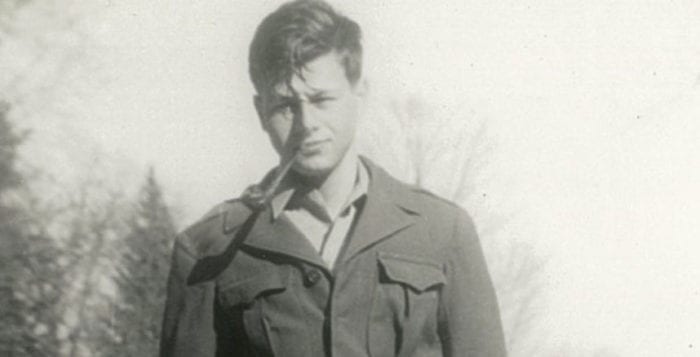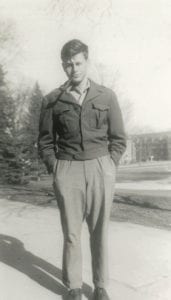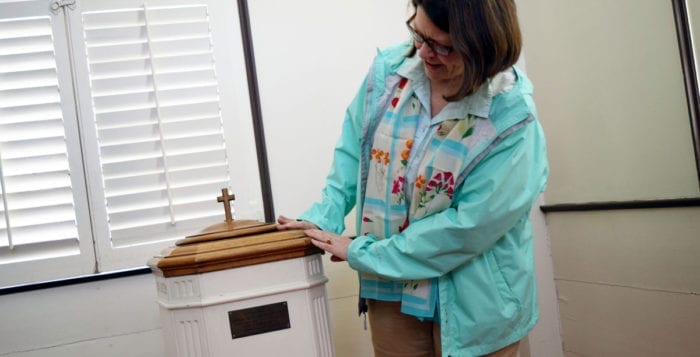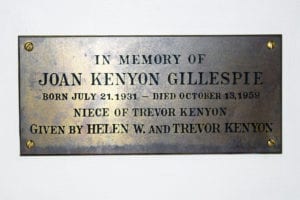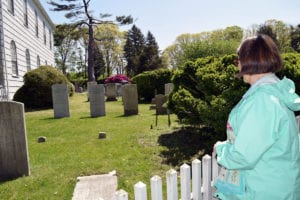By Alex Petroski
An idea that started as a seed about 15 years ago has sprouted into a full-blown tri-yearly tradition at North Shore Heritage Park in Mount Sinai.
The Parade of Flags, which is the brainchild of Mount Sinai resident Fred Drewes, takes place three times a year on Memorial Day in May, Independence Day on July 4 and Veterans Day in November. The first Parade of Flags was on July 4, 2010. The retired biology and environmental science professor created the event to promote national pride, teach kids about history, recognize those who have served our nation and help to express a “sense of country.”

The parade occurs on the Avenue of America, which is a few hundred feet of the nearly one-mile perimeter of the park. The avenue features approximately 100 flags on parade days, which includes flags from all 50 states arranged in the order of when they ratified the Constitution, flags for United States territories, previous versions of the American flag, flags of U.S. armed forces and many more. Signs that provide information about when the state joined the Union, state mottos and pictures of state coins and symbols accompany the flags. The avenue is also lined by each state’s official tree. The flags are assembled in the morning on parade days by volunteers just before 9 a.m., and then retired at 4 p.m.
“When people walk through the flags they just revel in the feeling and it also lifts spirits,” Drewes said in a phone interview last week.
Drewes has created something truly special, though he often attributes credit to the Heritage Trust, a nonprofit organization responsible for overseeing the park, and other volunteers like the Boy Scouts and community members who make the event possible three times a year.
“This is all something that Fred created — he never really gives himself much credit,” said Paul Dodorico, a Mount Sinai resident who volunteers with his wife Carol to help assemble and retire the flags, in a recent interview. “Seeing the flags on a sunny day with a little breeze —it’s just beautiful.”
Dodorico added that it’s important for kids and adults alike to learn and remember why holidays like Memorial Day, Independence Day and Veterans Day are celebrated and indicated that Drewes has established an enjoyable and visually memorable way for community members to do just that.
A guided tour of the avenue begins at 11 a.m. on Memorial Day.
The park features some other patriotic imagery like the Court of America, which is a sitting area with benches, plaques with quotes from presidents and other famous citizens and a rock garden in the shape of the continental United States. The rock garden is full of symbolic rocks, plants and flowers that are native to the region in America where they lay in the corresponding region of the garden. Blocks featuring the names of all 44 U.S. presidents and the years they held office border the garden.
A scavenger hunt will be available to help visitors interpret the representations found in the landscape and Parade of Flags.
The landscape, flags, plaques, plants, flowers and everything else that makes the avenue and park as a whole special were donated and arranged by volunteers.
Bob Koch of Koch Tree Services in Mount Sinai, who has had a hand in many features of the park including donating the state trees lining the avenue, also praised Drewes for his vision and hard work. “It really pays tribute to our country,” said Koch in an interview Monday. “It makes me appreciate being here.”
’Seeing the flags on a sunny day with a little breeze — it’s just beautiful.’
—Paul Dodorico
Drewes has kept a visitor’s book containing testimonials from people who attended the Parade of Flags over the years. Accolades including “A wonderful experience to share with my kids!,” “Thanks for the history,” “Well done. A beautiful tribute to our country,” and “A remarkable display, schools should visit,” jump from the pages.
Drewes said those thinking about attending the parade on May 30 should “expect to spend time and learn about the growth of our country and learn about the symbols and representations of states and territories of the United States.”
The 7th annual Memorial Day Parade of Flags will be held at Heritage Park, 633 Mount Sinai-Coram Road, Mount Sinai, on May 30 from 10 a.m. to 4 p.m. Free. Inclement weather cancels. For further information, call 631-509-0882 or visit www.msheritagetrust.org.
Other parades around Suffolk County
The following Memorial Day parades and services will be held in remembrance and to honor our nation’s fallen war heroes:
Calverton: Calverton National Cemetery, 210 Princeton Blvd., Calverton will hold a Memorial Day service on May 30 at 1 p.m. For further information, call 631-727-5410.
Centereach: The Centereach Memorial Day Parade will be held on May 29 at 1 p.m. beginning at the corner of Middle Country Road and Henry Road and ending at the VFW Hall Post 4927 on Horseblock Road. Memorial service to follow. Call 631-585-7390.
Centerport: The Centerport Fire Department will host a Memorial Day Parade on May 30 starting at 10:30 a.m. The parade will run from Harrison Drive to Park Circle. For further information, call 631-351-3012.
Commack: VFW Post 9263 will sponsor the Commack Memorial Parade on May 30 at 10 a.m. The parade steps off from the corner of Jericho Turnpike and Larkfield Road with a ceremony at Cannon Park to follow. Call 631-368-9463.
East Northport: The Knights of Columbus will lead a Memorial Day Parade on May 30 at 12:15 p.m. from Clay Pitts and Larkfield Road north on Pulaski Road to John Walsh Memorial Park. Questions? Call 631-262-1891.
East Setauket: The Veterans of Foreign Wars, Post 3054, will host the annual Memorial Day Parade in East Setauket on May 30 at 11 a.m. The parade will follow the route along Main Street and 25A. Opening ceremonies will be held on the Old Village Green opposite Emma S. Clark Library. Closing ceremonies will be held at Memorial Park on Route 25A. Call 631-751-5541.
Farmingdale: Farmingdale Village will hold a Memorial Day Parade on May 30 at 10 a.m. The parade kicks off at the corner of Thomas Powell Boulevard and Bethpage Road and proceeds south on Main Street to Village Hall. A ceremony will follow. Call 516-249-0093.
Farmingville: The Farmingville Residents Association will host a Memorial Parade on May 30 at 11 a.m. kicking off on Horseblock Road just west of Granny Road and commencing at the memorial by the Nicolls Road bridge. Call 631-880-7996.

Greenlawn: The Greenlawn Fire Department will host a Memorial Day Parade on May 30 at 9 a.m. The parade will run from East Maple Road, south on Broadway to Greenlawn Memorial Park at the corner of Pulaski Road and Broadway. Call 261-9103.
Huntington: VFW Nathan Hale Post 1469 will host a Memorial Day Parade on May 30 at 11:30 a.m. The parade will run from the Big H shopping center north on New York Avenue to West Carver Street to Green Street to Main Street to Stewart Avenue. Call 631-421-0535.
Kings Park: American Legion Post 944 of Kings Park will sponsor the 92nd annual Memorial Day Parade on May 30 at 9 a.m. stepping off at the RJO School at the corner of Old Dock Road and Church Street and proceed west on Old Dock Road, east on Main Street to the Veterans Plaza at the corner of Church Street and Route 25 for flag ceremonies. Call 631-269-4140.
Melville: The Melville Fire Department will lead a Memorial Day Parade on May 30 at 10 a.m. stepping off at Bertucci’s on Route 110, south of the Northern State Parkway and will proceed to march on Route 110 to the fire house at 531 Sweet Hollow Road. Refreshments will be served. Call 631-423-2635.
Northport: Northport American Legion Post 694 will host a Memorial Day Parade on May 30 at 10 a.m. The parade will run from the north end of Laurel Avenue to Main Street to Northport Village Park. Call 631-261-4424.
Smithtown: This year’s Memorial Day Parade in Smithtown will be held on May 30 at noon from the corner of Main Street and Route 111, continuing west on Main Street to Town Hall, with a ceremony to follow. Call 631-360-7620 for additional information.
Sound Beach: The Sound Beach Civic Association will hold Memorial Day services at the Sound Beach Veterans Memorial Park on New York Avenue on May 30 at noon with a wreath ceremony. Call 631-744-6952 for more information.
Stony Brook: On May 30 at 9 a.m., VFW Post 3054 and American Legion Irving Hart Post 1766 will host a Memorial Day Parade in Stony Brook beginning at the Village Center, east on Main Street to Veterans Memorial Park. Ceremony to follow. Call 631-751-5541 for more information.
St. James: Veterans of Foreign Wars Post 395 will host the St. James Memorial Day Parade on May 30 at 10 a.m. The parade will step off at the intersection of Lake and Woodlawn Avenues and march to St. James Elementary School for a ceremony. For further information, call 631-862-7965.



